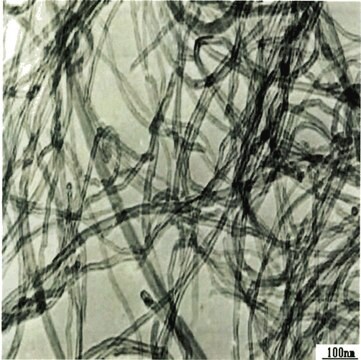652490
Carbon nanotube, single-walled
carboxylic acid functionalized, >90% carbon basis,D × L 4-5 nm × 0.5-1.5 μm , bundle dimensions
Synonym(s):
SWNT, carboxylic acid functionalized
About This Item
Recommended Products
Product Name
Carbon nanotube, single-walled, carboxylic acid functionalized, >90% carbon basis, D × L 4-5 nm × 0.5-1.5 μm , bundle dimensions, avg. no. of layers, 1
Quality Level
assay
>90% carbon basis
form
powder
feature
avg. no. of layers 1
extent of labeling
1.0-3.0 atom% carboxylic acid
D × L
4-5 nm × 0.5-1.5 μm , bundle dimensions
impurities
5-8% metals
solubility
H2O: dispersible 0.1 mg/mL
DMF: dispersible 1.0 mg/mL
functional group
carboxylic acid
Related Categories
General description
Application
Packaging
Physical properties
Preparation Note
Analysis Note
signalword
Warning
hcodes
Hazard Classifications
Eye Irrit. 2 - STOT SE 3
target_organs
Respiratory system
Storage Class
11 - Combustible Solids
wgk_germany
WGK 3
flash_point_f
Not applicable
flash_point_c
Not applicable
ppe
dust mask type N95 (US), Eyeshields, Gloves
Choose from one of the most recent versions:
Already Own This Product?
Find documentation for the products that you have recently purchased in the Document Library.
Customers Also Viewed
Articles
Recent advancements in paper-based sensing platforms offer cost-effective clinical diagnostics with microfluidic channels and colorimetric or electrochemical detection zones.
Carbon nanotubes are materials that possess remarkable properties and offer extraordinary possibilities.
Carbon-based Sustainable Organic Electronics (SOE) limit the use of critical elements and biodegrade at their end-of-life. This review offers insight on how structural and energy disorder in these materials influence device performance and includes evaluations of various transport models and their limitations.
Review on 1D vdWHs: Discusses materials, synthesis, optoelectronic applications, challenges, and future perspectives for 1D vdWH-based devices.
Our team of scientists has experience in all areas of research including Life Science, Material Science, Chemical Synthesis, Chromatography, Analytical and many others.
Contact Technical Service









